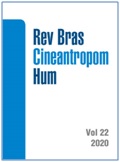Content validity evidences in the motor coordination test with ball
Resumen
The main objective of this study was to establish content validity evidences in the Motor Coordination Test with Ball (MCTB). Four Ph.D. professors and former sports coaches with academic experience in the motor coordination area took part of the validation process as experts. The experts assessed four motor tasks and graded using the Likert scale from one to five for criteria of clarity of language, practice relevance, and theoretical relevance. The content validity coefficient (CVC) has been used to determine the CVCc of each task and the CVCt for the instrument as a whole, adopting as a cutoff CVCc .70 and CVCt .80. The results showed good agreement among experts concerning “clarity of language” (CVC= .89), “practice relevance” (CVC= .81), and theoretical relevance (CVC= .86). For “practice relevance” of images and videos of task execution, there has been observed CVCt of .86 and CVCt of .95, respectively. When requested the order of relevance of coordination pressures, the agreement among experts presented the existence of at least four coordination pressures in each one of the tasks and, out of these, at least two had a higher relevance. After the calculation of the CVC, ecological validity was determined for the MCTB, accrediting it as an instrument for the assessment of motor coordination with ball in the context of sports games.
Citas
Barnett LM, Ridgers ND, Salmon J. Associations between young children’s perceived and actual ball skill competence and physical activity. J Sci Med Sport 2015;18(2):167–71.
Kröger C, Roth K. Escola da Bola - Um Abc para Iniciantes nos Jogos Esportivos - 2a Ed. Phorte editora: São Paulo; 2005.
Rudd J, Butson ML, Barnett L, Farrow D, Berry J, Borkoles E, et al. A holistic measurement model of movement competency in children. J Sports Sci 2016;34(5):477–85.
Caçola P, Ibana M, Ricard M, Gabbard C. Children with developmental coordination disorder demonstrate a spatial mismatch when estimating coincident-timing ability with tools. Res Dev Disabil 2016; 48:124–31.
D’Hondt E, Deforche B, Gentier I, Verstuyf J, Vaeyens R, De Bourdeaudhuij I, et al. A longitudinal study of gross motor coordination and weight status in children. Obesity 2014; 22(6):1505–11.
Luz, LGO, Teixeira AFS, Santos R, Padez C, Ferreira JP, Silva, MJC. Association between BMI and body coordination test for children (KTK). A meta-analysis. Rev Bras Med Esporte 2015;21(3):230-235.
Vandorpe B, Vandendriessche J, Vaeyens R, Pion J, Matthys S, Lefevre J, et al. Relationship between sports participation and the level of motor coordination in childhood: a longitudinal approach. J Sci Med Sport 2012;15(3):220-205.
Ferreira L, Vieira JLL, Rocha FF, Silva PN, Cheuczuk F, Caçola P, et al. Percentile curves for Brazilian children evaluated with the Bruininks-Oseretsky Test of Motor Proficiency, 2nd edition. Rev Bras Cineantropom Desempenho Hum 2020; 22:e65027.
Herrmann C, Gerlach E, Seelig H. Development and Validation of a Test Instrument for the Assessment of Basic Motor Competencies in Primary School. Meas Phys Educ Exerc Sci 2015;19(2):80–90.
Rosa Neto F. Manual de Avaliação Motora. 3rd ed. Florianopolis: DIOESC; 2015.
Silva SA, Zampier JELC, Silva FL. Valores de referência da coordenação com bola. Rev Acta Bras Mov Hum 2016;6(3):28–39.
Descargas
Publicado
Número
Sección
Licencia

Direitos Autorais para artigos publicados nesta revista são do autor, com direitos de primeira publicação para a revista. Em virtude da aparecerem nesta revista de acesso público, os artigos são de uso gratuito, com atribuições próprias, em aplicações educacionais e não-comerciais, desde que seja dada a atribuição. Esta obra foi licenciada com uma Licença Creative Commons Atribuição 4.0 Internacional - CC BY


